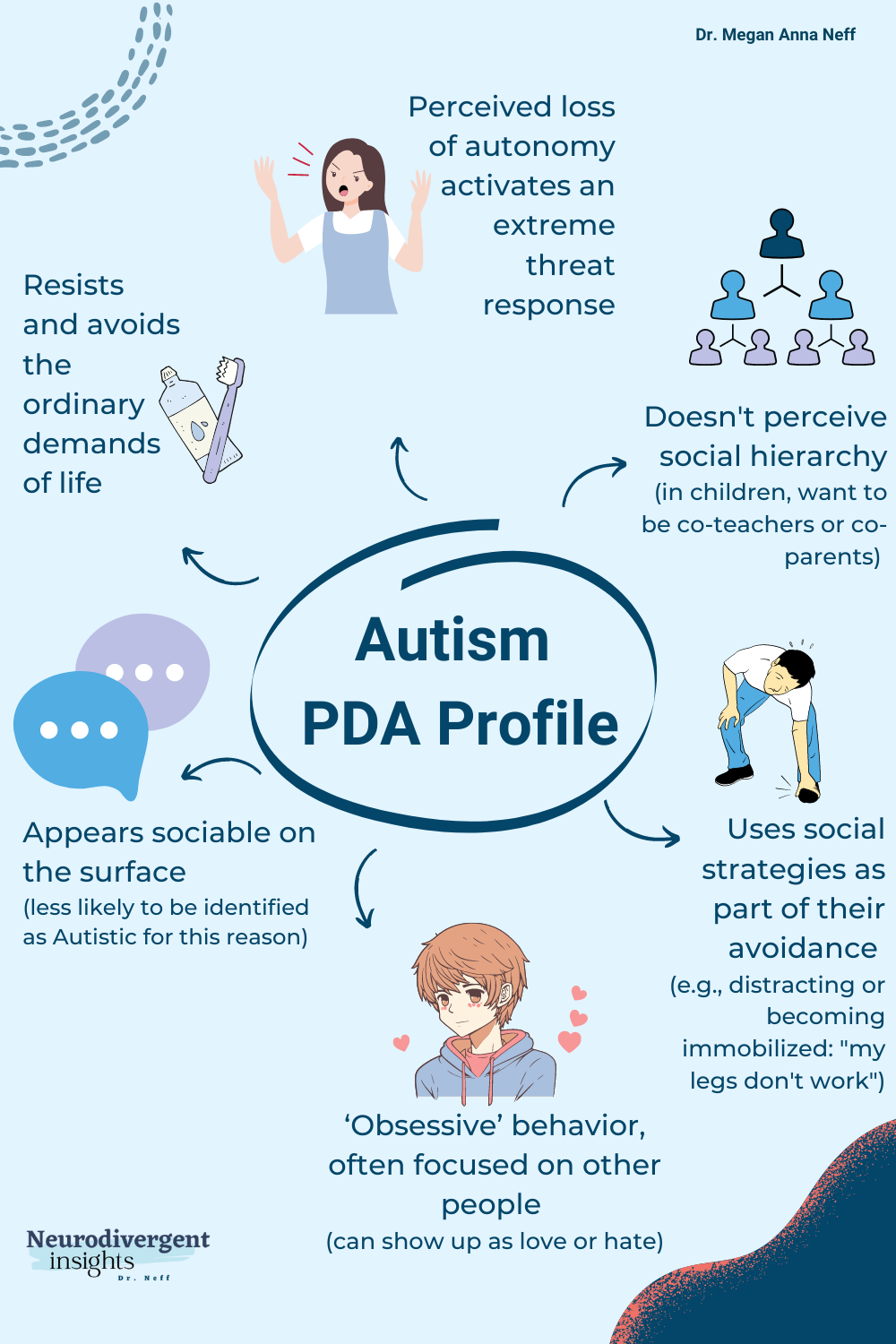What Does PDA Autism Look Like in Children?

Explanation of PDA (Pathological Demand Avoidance) in the context of autism spectrum conditions
Spotting Pathological Demand Avoidance (PDA), a behavior profile within the Autism Spectrum Disorder, in a child isn’t always straightforward.
I’d like to point out that the label isn’t as important as identifying and addressing the unique needs of your child and PDA Autism may be defined differently from one professional to another.
While Autism Spectrum Disorder is often characterized by difficulties in communication, social skills and sensory processing, children with PDA express these traits in a rather distinct manner.
Their behaviors are primarily driven by an overwhelming need to avoid everyday demands and expectations to an extraordinary degree, beyond what is commonly observed in children with autism.
It’s this avoidance that forms the crux of this blog post; providing parents and caregivers actionable points to identify and understand PDA in their kids.
PDA is a complex and controversial condition that often manifests in specific situations or contexts.
Some prevalent characteristics we’ll shed light upon in this blog post include: exceptionable resistance to ordinary demands, using social strategies as part of avoidance, appearing sociable on the surface but lacking depth in understanding, excessive mood swings and impulsivity, a fascination with role-play and pretending, to name a few.
As we progress through this blog post, we aim to touch upon each of these behaviors to provide deeper insight into the condition.
Understanding PDA in Autistic Children
The Expression of PDA
Description of how PDA can manifest
Children with PDA, a part of the Autism Spectrum Disorder, demonstrate exceptional avoidance behavior in response to everyday demands.
This behavior, however, can differ substantially from child to child. Some children might be able to bear spontaneous requests, adapting swiftly and without issue.
Others may react dramatically to the hint of a demand, even if it’s something they might ordinarily do with joy. The expression of PDA in children also varies along with the severity of Autism.
It’s more apparent in those with PDD-NOS Autism and high-functioning Autism compared to children with Asperger Syndrome.
How it varies from child to child
The avoidance behavior is chronic, but it’s far from consistent, making it tricky for parents and therapists to predict and respond.
While one task may be passionately refused on a particular day, the same task might be cheerfully undertaken on the following day.
Additionally, these children often exhibit motor planning difficulties and show significant variability in skills and performance.
That’s why an individualized approach in pediatric autism treatment is vital for these children.
Avoidance Behavior
Explanation of the nature of avoidance in PDA
Avoidance behavior is the defining characteristic of PDA.
The efforts that these children put into avoiding demands can be extraordinary and permeate all of their activities, including those in their free time.
The intensity of this behavior is typically seen in children who receive Therapy, which focuses on managing and minimizing these avoidance tendencies.
How this avoidance can influence behavior
Their complex behavior can often confuse those around them.
Take, for instance, a child who communicates smoothly, masking their Autistic communication difficulties, yet resolutely refuses to communicate when approached with a demand.
This dichotomy of behavior can make an early Autism detection challenging for professionals, but the resistance against ordinary demands often unveils itself over time.
Emotion Regulation
Breakdown of emotional responses in children with PDA
Managing emotions can be a challenging task for children with PDA.
Their responses to situations can be unexpected and disproportionately emotional, leading to excessive mood swings and impulsive actions.
Their difficulty in dealing with emotions often leads to a failure in comprehending the emotional context of situations or the feelings of others.
The connection between emotion and PDA behavior
This difficulty in emotional regulation is linked to their avoidance behavior.
Children with PDA often feel anxious due to their perceived lack of control. So, they resort to control their environment to cope with their anxiety.
Understanding this emotion-PDA behavior connection can open avenues for therapeutic strategies.
Considering that their underlying anxiety is a significant driver of their behavior, intervention approaches will aim to reduce anxiety and help these children lead more comfortable lives.
Tools for Recognizing PDA Behavior
Observation
The importance of being observant of behavior patterns
Observing and understanding behavior patterns is the first crucial step in recognizing PDA in children with Autism Spectrum Disorder.
This includes observing how they interact with the world around them, noticing their responses to demands, and being mindful of any resistance or avoidance patterns.
It’s not the child’s behavior in isolation, but its context that often provides the clearest insights into PDA.
Understanding the context of behavior
Numerous types of behaviors can fall under PDA, and while some might be easily observable, others may be devilishly subtle.
Sensory Processing, Communication Difficulties, and troubles with Social Skills are examples of experiences that can intersect with PDA.
These can mask PDA symptoms or cause them to appear disparate than expected. As a result, gaining a deep understanding of the child’s everyday experiences and environment is vital in this observation process.
Consistent Traits

Identifying consistent characteristics of PDA
PDA is characterized by consistent traits that deviate noticeably from customary behavior.
Typically, children demonstrating PDA show significant resistance to ordinary demands, even ones related to play or leisure.
They additionally tend to navigate their world in an anxiety-driven, control-seeking manner.
Comprehending these consistent characteristics of PDA can help caregivers and teachers better support the child through specialized therapeutic strategies
How these traits deviate from conventional behavior
Children with PDA often exhibit robust social mimicry and role-play skills, which sometimes mislead observers into overestimating their social comprehending abilities.
They can also display inconsistency in their skills, seemingly losing abilities they had previously mastered, particularly when their anxiety is high. A keen awareness of these traits can considerably assist in early Autism detection.
Specialist Insight
The role of specialists in diagnosing PDA
The role of professionals specializing in PDD-NOS Autism, Rett Syndrome, CDD, and other similar areas is crucial in diagnosing PDA.
These professionals are well-versed in Childhood Autism Symptoms, implications of different Autism Intervention Services, and the utility of Autism Speech Therapy.
They not only have the knowledge to understand the complexities of PDA but also have the tools to evaluate the child’s behavior.
Importance of professional evaluation in determining PDA
A specialist’s assessment isn’t only about ticking checkboxes on a list of symptoms.
It’s about considering the whole child – their strengths, their struggles, their likes, and their dislikes, within the context of their environment.
This comprehensive understanding allows professionals to accurately determine PDA, enabling more effective support and interventions for the child.
Supporting Children with PDA Autism
Responding to Avoidance Behavior
Strategies in managing avoidant actions
Responding effectively to the avoidance behavior typical in children with PDA, a subset of Autism Spectrum Disorder, entails careful understanding, empathy, and patience.
Strategies such as modifying the manner in which demands are communicated can be beneficial.
Instead of direct commands, opt for indirect requests or choices, making the child feel less controlled.
The importance of empathy and patience
Moreover, acknowledging the child’s feelings can work wonders.
Empathetic responses to their resistance − “I can see this is hard for you,” for instance – can alleviate their tension.
Reinforcement and rewards can sometimes backfire as they might be perceived as disguised demands.
As rockiness is a hallmark of PDA, patience becomes all-important.
Remember, Pediatric Autism Treatment is not a one-size-fits-all. Each child is unique and requires an individualized approach that best suits them.
Improving Emotional Understanding
Techniques to help children articulate their emotions
Kids with PDA often struggle in understanding and articulating their emotions, which is a key feature of Autism Social Skills deficit.
As such, helping them express their emotions can be immensely useful.
Techniques such as using visual tools or storybooks to describe emotions can help children better comprehend and express their feelings.
The importance of emotional validation for children with PDA
Emotional validation is an essential aspect for children with PDA.
Recognizing their emotions, especially during moments of high anxiety or stress, can provide them with a sense of understanding and security.
Moreover, emotional education and interventions like therapy can aid children in comprehending and dealing with their own emotions, an invaluable skill for children with PDA.
Collaborative Problem-Solving
The need for teamwork in managing PDA
When it comes to managing PDA successfully, teamwork is of the essence.
Collaborative problem-solving involves the child, family, and professionals working together towards a unified goal.
This approach offers the possibility of generating creative solutions catering to the specific needs and abilities of the child.
It enables everyone involved to share the same understanding, reducing conflicts and increasing acceptability of the solutions devised.
Importance of collaborative solutions between child, family and professionals
It’s important to remember that specialists in Intervention Services and therapists are key players in this collaboration.
Their experience and knowledge bring invaluable insight that aids in the development of practical and effective strategies customized to the child’s needs.
Ensuring that all voices, including the child’s, are heard can result in a mutually agreeable, comprehensive, and unique plan of action designed to support the child’s journey through Autism Spectrum Disorders, and most importantly, enhance their quality of life.
Wrapping Up
Acknowledging PDA in the context of Autism Spectrum Disorders holds paramount importance in ensuring that children with PDA receive the care and understanding they need.
A nuanced understanding of PDA can pave the way for more structured support tailored to these children’s unique needs, both at home and in educational settings.
Recognizing the signs, from themes of avoidance to challenging emotion regulation, is an essential step in this process.
Once identified, measures like therapeutic recommendations can be employed to offer the most effective support.
The complexity of PDA underscores the importance of specialist insights for a comprehensive understanding and diagnosing of this condition.
These professionals offer invaluable assistance in recognizing PDA symptoms and distinguish them from other Autism Spectrum conditions such as PDD-NOS Autism, CDD, and Rett Syndrome.
Lastly, remember, nothing sheds more light in darker places than knowledge and understanding.
The realm of Autism and particularly PDA is an ongoing journey of learning for parents, caregivers, educators, and medical professionals alike.
Continued interest, learning and development in this field will not only better the lives of children with PDA but will inevitably create an atmosphere of inclusion, acceptance and deep-rooted empathy that society so yearns for.
So, let’s fortify our efforts to unravel this complex condition and march ahead with determination for a better tomorrow for our children.

